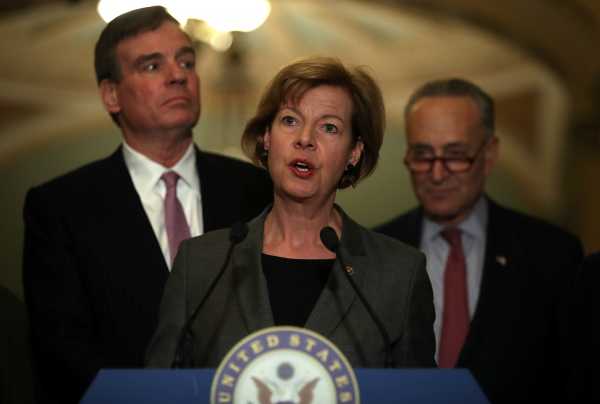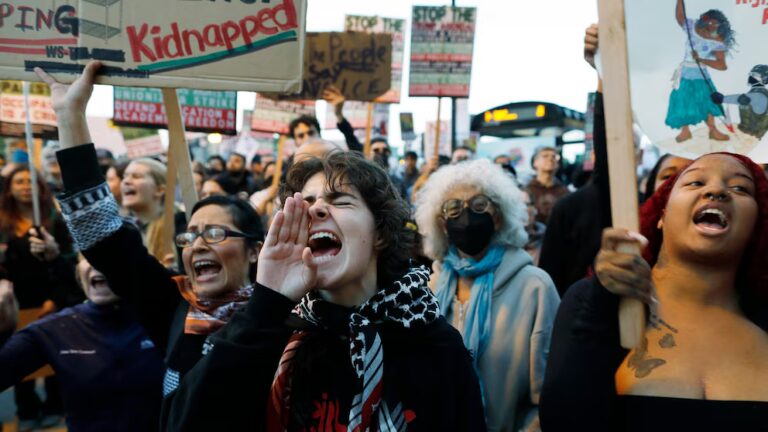
The past decade has been a slow-motion Republican conquest of Wisconsin.
Republican Gov. Scott Walker’s party now holds all but one of the statewide elected offices. Walker has radically diminished the power of organized labor. He overhauled welfare and imposed voter ID restrictions. The exclamation point for Republican rule in Wisconsin was Donald Trump’s victory, when he became the first Republican to carry the state since 1984.
Now, Walker’s party has one last move to seize total control — take out Democratic Sen. Tammy Baldwin in her first reelection campaign this fall. Baldwin is the most prominent progressive left in the state, and Republican dollars are already pouring in to defeat her. Baldwin is seeing as much outside money spent against her as any other Senate Democrat, even though six or seven other Democrats are expected to face stiffer challenges and she still doesn’t have a set Republican opponent.
“There is a strong motivation to finish the job” — that is, to definitively turn Wisconsin from purple to red by defeating Baldwin — is how a Wisconsin Democrat close to the Baldwin campaign put it to me.
With Walker overseeing the most radical state welfare cuts in the country and Speaker Paul Ryan shepherding through the most conservative agenda in a generation in the US House, Baldwin — a progressive who has endorsed Medicare-for-all — seems like an incongruity in the Badger State.
“A lot of people within the party feel: Why is Tammy Baldwin representing us when we’ve got Scott Walker, Ron Johnson, and Paul Ryan?” one Wisconsin Republican operative told me. “If Baldwin loses, you can say it’s officially a red state.”
The good and the bad for Tammy Baldwin
Wisconsin is ground zero, in many ways, for the 2018 midterms. Walker is seeking a third term as he dramatically cuts the state’s welfare spending and puts new restrictions on its Medicaid program. Ryan will either vie for his reelection or retire, with the real possibility if he leaves that a Democrat could replace the outgoing Republican speaker of the House.
Baldwin will be aided by some tailwinds. It’s always hard to beat incumbent senators, particularly in off years when their party is out of the White House — they win nine out of 10 times in those situations. Trump is not particularly popular in the state either; a new poll from Marquette University found that just 43 percent of Wisconsin voters approved of his job performance and 50 percent disapproved.
On the enthusiasm scale, the survey found that Democrats (64 percent) were more excited to vote than Republicans (54 percent) this fall. Democrats notably won a very red state Senate district in January that Trump had carried with ease. Some major fundamentals of the race are strongly in Baldwin’s favor.
But Baldwin isn’t Ohio’s Sherrod Brown, who is also an unrepentant progressive senator running for reelection in a rapidly reddening state but has a strong in-state brand. This is her first reelection, the first time she’ll go back before the voters when President Barack Obama isn’t on the ballot (she trailed the incumbent president’s vote share by a little more than a percentage point in 2012.
Wisconsin’s voters seem ambivalent about Baldwin after six years. The Marquette poll found that 37 percent of voters had a favorable impression of her and 39 percent had an unfavorable view. Her position had deteriorated a bit from a year ago, when 40 percent had a favorable view versus 35 percent unfavorable. One in five Wisconsin voters said they haven’t heard enough about Baldwin to have an impression.
The outcome of the Republican Senate primary could be crucial for framing the race. A Walker ally offers a clean narrative. But as the Republican operative said: “If you have an outsider running, not as closely identified with Walker, that’s an advantage against Tammy Baldwin.”
The primary isn’t until August, so there is plenty of time for the GOP race to heat up and shake out. But there seems to be a pretty strong delineation. Kevin Nicholson, a veteran and business consultant, will run as the outsider. But he is also likely to weather attacks that he used to be a Democrat; he was actually the president of College Democrats of America years ago. Leah Vukmir, a conservative state senator who has been in the state legislature since 2002, is more closely aligned with Walker and the establishment.
Neither has a decisive advantage for now. The Marquette poll put Nicholson at 28 percent support and Vukmir at 19 percent, with 49 percent undecided.
But in a very real sense, the Wisconsin Senate campaign might be defined more by the governor’s race, where the divisive Walker will go before voters for the fourth time in eight years.
“For Tammy’s camp, she probably would rather take on someone who’s close to Walker,” the GOP operative told me. “She can be the Walker slayer. She can take out her Senate opponent and Scott Walker if things go really well.”
Tammy Baldwin is really running against Scott Walker
The Republican governor has dominated Wisconsin politics since 2010. He fought off a recall election in 2012 and won reelection comfortably in 2014. He has been the master of his own destiny: As the New York Times documented during his failed presidential bid, Walker is notoriously hands-on when it comes to political strategy.
He has turned Wisconsin into one of the most radically conservative state governments in the country, outside of perhaps the Deep South. He famously cracked down on the collective bargaining rights of the state’s public sector unions, the backlash from which motivated his attempted recall. He helped make Wisconsin a right-to-work state. He signed a restrictive voter ID bill into law. He has cracked down on abortion rights and rejected Obamacare’s Medicaid expansion.
For his next act, Walker has shepherded through one of the most restrictive welfare reform proposals in the country this year. The package, which he will soon sign into law, will impose harsh work requirements and other restrictions like drug testing for low-income people who receive food stamps, housing assistance, and health insurance from the state.
He has been weighed down, however, by a notorious deal the state cut with Foxconn, which produces iPhone screens, to build a new plant in Milwaukee. That deal included $4.5 billion in tax and other incentives; Walker and Trump have hailed it as a victory for US manufacturing. But the recent Marquette survey found that a strong plurality of voters (49 percent) believed the plant would not be worth the generous terms the state offered the company.
After such a contentious tenure, and despite his Republican Party’s success in consolidating almost all of the state government’s power, Walker is still a remarkably divisive governor. The Marquette poll showed voters evenly divided: 47 percent approved of his job performance, and 47 percent disapproved.
All of this, the foundation of Walker’s role as the biggest Democratic boogeyman in the state, helps explain why state-based operatives from both parties believe Baldwin will be best served by a campaign run in opposition to Walker.
“You couldn’t have two more different people,” Scot Ross, who leads the progressive group One Wisconsin Now, told me. “First thing Walker does in the morning is check the polls, stick his finger in the air, and then figure out how to spend our tax dollars based on the first two. Tammy is just totally different. She gets up in the morning and wants to help people. I don’t see how you could have a better contrast.”
The Republican strategist noted to me that Walker has never won an election with more than 52 percent of the vote. So while he has managed to bend Wisconsin to his will, there is not an overwhelming Walker coalition — and the Democratic base is motivated to beat him this year.
Republican donors want to oust Baldwin and turn Wisconsin red for good
Meanwhile, the GOP donor dollars are pouring in against Baldwin. By mid-March, outside conservative groups had already spent $8.5 million in Wisconsin, according to a summary provided to Vox. For context, during the entirety of Baldwin’s 2012 Senate race — during a presidential election year, when spending is always higher — anti-Baldwin forces spent about $20 million.
The money is coming from the usual suspects: groups aligned with the Koch brothers and organizations affiliated with Dick Uihlein, a conservative businessman with longtime Wisconsin ties, plus a little bit from the National Republican Senate Committee, which will surely become more involved once there is an official Republican nominee.
“There is more excitement to go on offense than be on defense in some corners,” the Republican operative said of the party’s mood heading into the campaign.
They’ve targeted Baldwin on some of the expected ground — like opposing the Republican tax plan — but there is one Wisconsin-specific issue that GOP operatives want to make a big deal of through November.
One outside group, Concerned Veterans of America, is trying to tar Baldwin with the Tomah Veterans Affairs hospital scandal. Baldwin has been criticized after an inspector general report surfaced indicating that she had sat on a report about the possible overprescription of painkillers at the hospital where a veteran overdosed and died.
“If she loses, that’s probably the main reason why she loses,” the GOP operative said.
Left unsaid in those attacks, her campaign would note, is that Baldwin actually helped to get a law passed in 2016, one she worked on in with the family of the veteran, designed to strengthen opioid prescribing practices at the VA.
Baldwin’s path runs through health care and Obama/Trump voters
Walker’s divisiveness, a fierce Republican primary, and the natural tendency for voters to punish the party in power during midterms should be advantages for Baldwin. But on her own terms, she is taking up health care as a signature issue, on the backs of Republicans’ failed attempts to repeal Obamacare and the Trump administration’s undermining of the law.
State Republicans, led by Walker, have refused to expand Medicaid, but Wisconsin has still seen its uninsured rate fall nearly in half under the Affordable Care Act.
“Her signature issue right now is health care. Every alternative that the Republicans are offering activates progressives, and the independents are like, ‘I’m not sure about this one, gang,’” Ross said. “I think that is a feather in Sen. Baldwin’s cap.”
Baldwin is uniquely situated to talk about the health care debate: She endured a three-month hospital stay when she was 9 years old and has been labeled with a preexisting condition ever since.
With the Trump administration waging a quiet campaign to bring back preexisting conditions — even though the ACA’s effort to eliminate such discrimination is one of its most popular achievements — she has introduced a bill to block proposed regulations that would undercut the law’s protections. Baldwin also endorsed Bernie Sanders’s Medicare-for-all plan and various other Democratic proposals to expand Medicare and Medicaid.
“There are so many parents or foster parents or grandparents who either worry about financial ruin if they get a sick child what they need or they worry: ‘Can we hold off, can we hold off?’” she told me recently. “The administration isn’t looking at the whole picture and is being disingenuous because they’re smart enough to look at the whole picture.”
So the senator will offer herself up as a palatably progressive alternative — “there’s a certain every-person quality to her,” as Ross put it — to the radically conservative agenda that the state has seen under Walker.
There is still the problem, though, of Wisconsin’s conservative turn.
To put it simplistically, the state more or less breaks down between the progressive conclaves of Madison and Milwaukee and everywhere else. Barack Obama won twice because he was able to really run up the numbers in the urban areas and perform well enough with blue-collar voters. Hillary Clinton didn’t do as well in the metro areas, support fell off in the rural parts of the state, and she just couldn’t make up the difference with the Never Trump suburban Republicans.
As the Republican operative put it to me, there are about 75,000 Never Trump voters and 75,000 Trump Democrats. That is likely to be the decisive demographic in Wisconsin this year. Baldwin has to hold on to some of the first group, even with Trump off the ballot and more conventional Republicans in his place, and regain some of the latter.
As the strategist said, “150,000 voters could really be the difference between whether Wisconsin is truly a red state going forward.”
Sourse: vox.com






